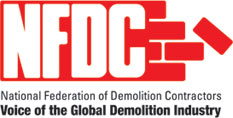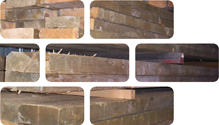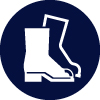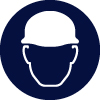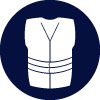
Dimensional Timbers Wood 17 02 01
Dimensional timbers are found in various sizes, wood types and shapes. They are originally cut to size in various thicknesses and lengths, depending on the specification required. They are of varying quality, from large dimensional floor joists and purlins, to thin strips of treated slate battens. Some are planed all round to suit a smooth, architectural finish.
Usage & Probable Locations
Dimensional timbers have many uses in buildings. They are used for floor joists, floorboards, rafters, purlins, trusses, stud walls, cladding, structural frames, fascia boards and all manner of carpentry and joinery. Timber may be located in all areas of a house, but in concrete or steel frame buildings will mostly be found in floors, roofs and stud walls.
Personal Protective Equipment
PPE requirements indicated are for guidance purposes only. DRIDS has identified the PPE that is mandatory on all demolition projects and ones that may be required subject to site specific Risk Assessment & Method Statement (RAMS). Hover over the icon to determine the types of PPE required for the removal of this material.
Removal, Segregation & Storage
Depending on how dimensional timbers have been fitted for use, will determine how they are removed, segregated and stored. Reasonably sized timbers in good condition and not coated with glues or bitumen will have a reuse value, especially if there is a large number of similar size. They should be segregated and stored flat on timber skids, with thin latts placed across them every four timbers deep. They should be stored inside or covered with plastic or tarpaulin sheets to keep them dry. They should also be stored away from plant movements to prevent splash damage or breakage.
Tools
Fixtures, Fittings & Connections
Sprung floors, roof systems, timber walls and cladding has been traditionally fixed in place with nuts and bolts, nails, screws, dowels, mortar or a glue. Some timbers will incorporate a variety of joints that have been cut into the timbers to provide strength and integrity. Fascia boards, soffits, skirting boards, architraves, window frames and door frames will often be coated with paints or preservatives. Floor joists, rafters and purlins will often be built into stone or brick walls without any fixings other than mortar.
Health & Safety
Subject to task-specific Risk Assessment & Method Statement (RAMS). Use correct protective equipment for removing fixings, especially bolts, nails and screws. Wear gloves when handling timbers with damaged edges, coated in bitumen or adhesives to prevent irritation, cuts and splinters. Wear eye protection when removing nails with a crowbar, hammer or nailbar and at all times when using chisels. Use gloves and eye protection when using electric tools including reciprocating saws.
